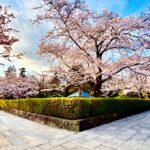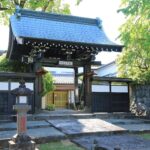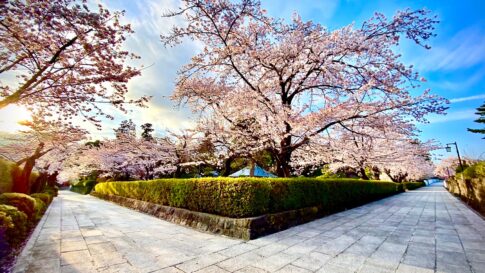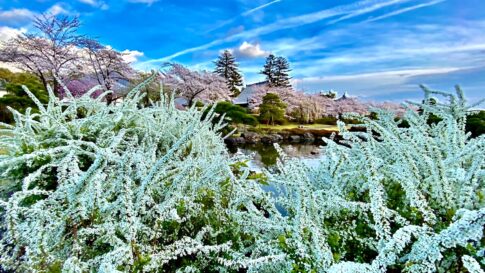1. Birth
On February 16th, 1222 (first year of Jo-o), approximately 770 years ago, Nichiren Daishonin was born in the fishing village of Kominato in Tojo District of Awa Province (currently Chiba Prefecture). His childhood name was Zennichi-maro. His father, a poor fisherman, was named Mikuni no Tayu Shigetada and his mother was called Umegiku. In one of his writings (called Gosho) the Daishonin states, “Nichiren is a child of a Sendala family from the beaches of Tojo in Awa, Japan.” Sendala means a person from the lowest cast in ancient India whose profession involves the killing of animals. The Daishonin held no social status in the society of his day. But in the form of a common mortal, the Daishonin’s behavior was that of the true Buddha in the Latter day of the Law. Out of his great compassion, the Daishonin demonstrated that anyone, regardless of social station, has equal potential to attain Buddhahood just as he is.
2. Entering Priesthood and Religious Practice
In 1233, at the age of 12, Zennichi-maro climbed to an historic old temple, Seicho-ji, on Mount Seicho near Kominato. He began his studies as the disciple of the chief priest, Dozen-bo. Four years later, in 1237, when he was sixteen, he officially became a priest, shaving his head and changing his name to Zesho-bo Rencho.
The world of Buddhism at that time fully manifested the characteristics of the Latter Day of the Law when the Pure Law had been lost. Although all the predominant sects of the day; Nembutsu, Zen, Shingon, Ritsu and Tendai derived from Shakyamuni’s teachings, it was not clear which Buddhist religion was correct. Amidst such chaos in the Buddhist world, Rencho believed that the true teaching of the Buddha must be only one. Motivated by a great desire to liberate all people from their illusions and sufferings he sought the true religion. To this end, two years after he entered the priesthood, Rencho embarked upon a journey of advanced study. He traveled to Kamakura, Mount Hiei and other religious centers studying all extant religious doctrines.
3. Declaration of the Establishment of True Buddhism
Having thoroughly mastered the doctrines of Buddhism, Rencho returned from his journey of study at the age of 32. On March 28th, 1253, standing alone at the top of Kasagamori peak on Mount Seicho, he powerfully chanted the Daimoku of Nam-Myoho-Renge-Kyo for the first time. With this he declared to the universe the establishment of true Buddhism. At that time he changed his name to “Nichiren” (Sun Lotus). After he climbed down the mountain, he gave a first sermon to his parents and his older fellow disciples; Gijo-bo, Joken-bo, Joen-bo at the Jibutsu-do hall of Dozen-bo’s lodging temple called, Shobutsu-bo at Seicho-ji. In this sermon the Daishonin made clear by citing documentary proofs that Nembutsu, Zen, and other sects prevalent at that time, are erroneous teachings, which go against the true intention of Shakyamuni.
Because his teaching refuted the popular sects of Buddhism, potentially antagonizing the secular authorities who adhered to them, the Daishonin’s parents became fearful for their son and pleaded with him to reconsider his views. The Daishonin, however, taught and guided his parents patiently until they finally became the first believers of True Buddhism.
On April 28th, one month after his first sermon, the Daishonin once again took the master’s seat to present his doctrines. Facing the south side of the Jibutsu-do hall of Shobutsu-bo at Seichoji temple, he called himself “Nichiren, the Votary of the Lotus Sutra,” and addressed his audience.
The contents of his presentation shocked the religious world of his day and had a tremendous impact on the people who were gathered there. He immediately became the target of Tojo Kagenobu, the steward of the area and a strong Nembutsu believer, who that very day made his first attempt upon the Daishonin’s life. But with the help of Joken-bo and Gijo-bo, the Daishonin managed to escape the crisis. Since the Daishonin fully expected to meet this kind of great persecution, his great compassion and desire to save all people and commitment to propagate true Buddhism never wavered. On the contrary, the Daishonin determined that further propagation activities should be undertaken in Kamakura, the political center, in order to save the entire Japanese nation.
4. The Rissho Ankoku Ron (On Securing the Peace of the Land Through Propagation of True Buddhism)
Once the Daishonin reached Kamakura he built a small residence at Matsubayatsu in Nagoe from which he would go out to the streets of Kamakura to propagate true Buddhism and refute erroneous doctrines of the prevalent religions. The people’s suffering in those days was beyond description because of the unusually frequent occurrence of natural disasters and calamities including earthquakes, epidemics and famine. When a particularly huge earthquake struck in August of 1257, it provided the immediate motive for the Daishonin to write, the Rissho Ankoku Ron (On Securing the Peace of the Land Through the Propagation of True Buddhism) to clarify the cause of Japan’s misery. The gist of the writing is that the fundamental cause for the disasters lay with the sovereign and the people’s adherence to heretical sects and doctrines which were in opposition to orthodox Buddhism. He stated that if the people did not convert to the True Law and discard their attachment to erroneous teachings, two additional disasters, internal strife and foreign invasion, would occur without fail.
Having heard the painfilled outcry of the people, the Daishonin poured his entire soul into the document called the Rissho Ankoku Ron, resolutely taking his stand. Explaining his reason for submitting this bold warning to the government, the Daishonin stated, “I am saying this entirely for the sake of the nation, for the sake of the Law, for the sake of the people and not for the sake of myself.” On July 16th 1260, the Rissho Ankoku Ron was submitted to the most powerful person within the Kamakura shogunate, the retired regent, Hojo Tokiyori (Saimyoji Nyudo) through the offices of Yadoya Saemon Nyudo, an official of the Kamakura government. The Daishonin was 39 at the time of this first remonstration with the government.
5. Persecutions
Unwilling to end their support of heretical religions, the military rulers of Japan responded to this important remonstration by initiating a number of violent persecutions. On the night of August 27th, 1260, approximately one month after submission of the Rissho Ankoku Ron, Nembutsu monks backed by the government as well as their followers, banded together to assault the Daishonin’s thatched hut in Matsubagayatsu. Narrowly evading his attackers, Nichiren Daishonin departed Kamakura seeking refuge with Toki Jonin, a prominent believer in Shimousa Province. This incident is called the “Matsubagayatsu Persecution.”
The Daishonin returned to Kamakura in the following year, 1261, where he engaged himself in even more intense propagation activities. The Nembutsu believers were astonished by the Daishonin’s unshakable resolve and realized that in formal debate they could never defeat him. Having failed in their attempt to kill him at Matsubagayatsu, the Nembutsu monks appealed to the government officials to covertly dispose of the Daishonin.
Since Hojo Nagatoki, the ruler at that time, together with his father, Hojo Shigetoki, hated Nichiren Daishonin, he positively received the request of the Nembutsu believers. Although the Daishonin had done nothing illegal, on May 12th, 1261, he was exiled to Ito on the Izu Peninsula. This is called the “Izu Exile.” The Izu Exile together with the Sado Exile (which occurred ten years later) were formal persecutions from the government and were described in detail in many Gosho passages.
While the Daishonin was in exile in Izu, both Nagatoki and Shigetoki Hojo received the consequences of their slander against Buddhism; Nagatoki fell ill unable to rise from his bed and Shigetoki died insane. Having witnessed such punishment from the Buddha or for some other unknown reason, the authorities pardoned Nichiren Daishonin in February 1263 after one year and nine months in exile.
After being pardoned, the Daishonin who had been away from his hometown for 12 years, returned to Awa Province where he involved himself in teaching and nurturing his disciples. However, Tojo Kagenobu had, ever since the establishment of true Buddhism, harbored hatred for the Daishonin and watched vigilantly for an opportunity to harm him. On November 11th, 1264, while the Daishonin was en route to Komatsubara, the home of his disciple, Kudo Yoshitaka, Tojo Kagenobu saw his chance. Intent upon assassination, Kagenobu and hundreds of his soldiers ambushed the Daishonin. In the harsh battle, Kudo Yoshitaka, was slain and the Daishonin himself received a sword cut upon the forehead. This incident is referred to as the “Komatsubara Persecution.”i One of traditional Buddhism’s Five Cardinal Sins is to cause a Buddha to bleed. Tojo Kagenobu, who injured the revered body of Nichiren Daishonin, is said to have gone mad and died within three days of this incident.
6. The Eleven Letters
When the Daishonin returned to Kamakura in 1269, a letter from the Mongol Emperor, Kublai Khan, also arrived. Foreign Invasion as predicted by the Daishonin in the Rissho Ankoku Ron eight years previous, now loomed as a real threat to the nation.
On October 11th, 1269, the Daishonin sent letters urging the government and eleven religious leaders to hold an open religious debate to determine the proper teaching to protect the nation in its time of crisis. He stressed the need for the Japanese people to immediately renounce heretical religions and convert to the correct Law. In these eleven letters erroneous doctrines of various religions are refuted by the now famous Four Dictums: “Nembutsu leads to the hell of incessant suffering; Zen is the teaching of devils; Shingon will ruin the nation and Ritsu is traitorous.”
The government as well as the monks of the seven major temples were shocked and angered by the eleven letters. Not only did they reject the Daishonin’s strict warnings, they decided to suppress him.
7. Discarding the Transient Figure and Revealing the True Identity
In 1271, a large-scale drought hit the entire country of Japan. The government ordered Ryokan of Gokurakuji temple, a monk of the Ritsu sect, to pray for rain. Nichiren Daishonin sent a message to Ryokan challenging him to determine whose teaching was correct based on the effectiveness of their prayers for rain. In the end, Ryokan was completely defeated. However, Ryokan, mortified because his prayers were unanswered, was underhanded enough to conspire with monks of various sects to persuade the government to eliminate the Daishonin, once and for all. On September 10th, the Daishonin was summoned to the magistrate’s office for questioning at which time he admonished his interrogator, Hei no Saemon Yoritsuna, the Deputy Director of the Office of Military and Police Affairs, to establish through debate whether he, Nichiren Daishonin, or the teachers of the other sects was right. On September 12th, Hei no Saemon and a few hundred of his troops violently assaulted the Daishonin in his thatched hut in Matsubagayatsu. The Daishonin, however, assumed a solemn attitude, stating, “Look at Hei no Saemon nojo’s insane attitude. To lose Nichiren is the same as felling the pillar of Japan.i Hearing this statement, the color drained from the faces of all the soldiers including that of Hei no Saemon nojo.
The Daishonin was arrested as if he were a major criminal. And, without a trial, on the night of the 12th, he was sent under armed escort to the execution ground in Tatsunokuchi. The authorities’ intention was to secretly execute the Daishonin who was innocent and could not, according to national law, be legally punished.
As the time for his beheading approached, the Daishonin readied himself at the place of execution. The moment the executioner raised his sword to strike, a brilliant light as bright as the moon came from the direction of Enoshima Island shooting across the sky towards the northwest.

The executioner was blinded by the light and dropped to the ground. Frightened, the other soldiers fell from their horses or rode away. No one was able to take the Daishonin’s life. This event is called the “Tatsunokuchi Persecution,” and it had a profound significance in the course of the Daishonin’s life.
At the Tatsunokuchi execution site, the Daishonin relinquished his transient identity as the reincarnation of Bodhisattva Jogyo, who is described in the Lotus Sutra as having received the essence of the Lotus Sutra from Shakyamuni. From that time forward, he revealed his true original identity as the True Buddha who appears in the Latter Day of the Law to establish the true Buddhism which will enable all mankind to attain Buddhahood.
This does not mean that the common mortal, Nichiren became a Buddha for the first time at Tatsunokuchi. Rather the True Buddha, Nichiren Daishonin, proved by fulfilling all prophecies and overcoming all persecutions, the fact that he is the original Buddha. Thus, after the Tatsunokuchi Persecution, the Daishonin finally began to commit himself to various activities from the standpoint of the True Buddha.
8. Exile to Sado
After the failed execution attempt at Tatsunokuchi, the Daishonin was temporarily transferred to Echi in Sagami Province. While he was in Echi, numerous incidents of arson and murders were committed in Kamakura by Nembutsu believers. However, the Daishonin’s followers were blamed. The government used these crimes to justify persecuting the Daishonin’s disciples and believers. Frustrated in their attempt to assassinate the Daishonin, the generals ruling Japan decided to quickly dispose of him by exiling him to Sado Island. On October 10th, 1271, he was escorted under guard from Echi to Sado where he arrived on the twentieth of the same month.
In the 13th century, severe cold weather prevailed throughout the world including Japan. Especially in Sado which faces the Northern Sea, with winter coming, the cold must have been unbearable. In such an intensely cold place, the Daishonin’s was confined to a small hut called Sanmaido located in the local graveyard of Tsukahara where corpses were abandoned. His small dwelling had holes in its roof and its walls were near collapsing. The place was such that ordinary people could not sustain their lives since food and clothing were hardly available.
No matter how severe the conditions were, they could not destroy the unshakable life of the True Buddha. On the contrary, it was here at the Tsukahara Sanmaido that the Daishonin, who had discarded his transient identity and revealed his true identity as the original Buddha, wrote the Kaimoku Sho (The Opening of the Eyes) in which the object of worship in terms of the person is revealed.
In February 1272, the Daishonin’s prediction of internal strife came true. This was the incident in which the shogun, Hojo Tokimune’s elder half brother Tokisuke, unsuccessfully attempted to make himself shogun. Fighting resulted in Tokisuke’s death. After having seen that the Daishonin’s prophecy about the internal strife proved right, the government was overcome with terror and decided in haste to transfer the Daishonin from Tsukahara Sanmaido to the residence of Ichinosawa Nyudo. In the following year, 1273, the Daishonin authored the Kanjin no Honzon Sho (The True Object of Worship), which reveals the object of worship in terms of the Law.
In 1274, the government received intense pressure from Mongolian envoys demanding Japan’s submission to the Mongol Empire. At the same time, mysterious phenomena such as the simultaneous appearance in the sky of the sun and venus occurred one after another. Witnessing these ominous events and recalling the Daishonin’s predictions, Hojo Tokimune decided to bring him back to Kamakura. On February 14th, 1274, having spent two years and several months in exile upon Sado, the Daishonin was pardoned and returned to Japan’s political center.
9. True Objective of the Daishoninis Advent
Upon arriving in Kamakura, the Daishonin was summoned to the military regime’s compound where he was once again confronted by Hei no Saemon. Assuming a completely different posture from their previous encounter, Hei no Saemon politely welcomed the Daishonin and asked questions regarding a possible Mongolian attack and other matters. In reply, the Daishonin compassionately expounded his Buddhism and explained, “It is certain that the Mongols will invade Japan within this year. You should immediately abjure your heretical beliefs and devote yourselves to the correct teaching.” The government, however, rejected his admonition. Failing to comprehend the Daishonin’s intent, they even considered having the Daishonin join together with monks from heretical religious sects such as Nembutsu and Shingon to pray for the peace and security of the nation.
Having realized that the government would not be awakened to the correct teaching and following an old maxim that says a sage who warns his sovereign three times and is not heeded should withdraw to a mountain forest, the Daishonin left Kamakura for Mount Minobu on May 12th, 1274. He entered the wilderness of Minobu in order to establish a site to train his disciples for the perpetuation of the true Law. He then dispatched his priest disciples to various locations in order to actively propagate true Buddhism. Once again, tremendous opposition arose in the course of these propagation activities. Of these, the most severe persecution took place in 1279 in Atsuhara village of the Fuji area where 20 believers were arrested and tortured. Among them the three brothers, Jinshiro, Yagoro, and Yarokuro were beheaded when they refused to abandon their faith in the Buddhism of Nichiren Daishonin. Seeing that his believers’ faith had grown to the extent that for the sake of Buddhism, they did not begrudge even their lives, the Daishonin felt that the right time had come. Thus, on October 12th, 1279, the Daishonin inscribed the Dai-Gohonzon, the Supreme Object of Worship of the High Sanctuary of True Buddhism, which was the ultimate purpose of his advent.
10. Entering Nirvana
By 1281, the Daishonin had for over 30 years been ceaselessly devoting himself to propagating the True Law under the harshest of circumstances and in spite of innumerable persecutions. It was around this period that his physical condition gradually began to weaken.
In September 1282, at his disciple’s urging, the Daishonin decided to leave Minobu for Hitachi to recuperate in that area’s hot springs. Having fulfilled his mission, the Daishonin knew the time for his nirvana was approaching. Therefore, before he left Minobu he summoned Nikko Shonin and bestowed the “Minobu Transfer Document” (Document for Entrusting the Law which Nichiren Propagated Throughout His Life) upon him. This documented the exclusive transmission of all his Buddhist teachings to Nikko Shonin.
Then on September 8th, guarded by his disciples, the Daishonin departed Minobu. On September 18th the Daishonin’s party stopped over at the residence of Ikegami Munenaka, a disciple in the Ikegami area of Musashi (currently Tokyo, Ohta Ward). The Daishonin had intended to stay at the Ikegami residence for just a few days but the weakening of his body was progressing rapidly. On the morning of October 13th, the Daishonin wrote an additional transfer document entitled, the “Ikegami Transfer Document” which together with the “Minobu Transfer Document” constitute the “Two Transfer Documents” clearly designating Nikko Shonin as the Daishonin’s successor.
Then at eight o’clock on the morning of October 13th, the Daishonin peacefully entered Nirvana displaying the countenance of the eternal True Buddha even as his mortal body passed away. He was sixty-one years old. It is said that at that very moment the earth trembled and the cherry trees in the garden bloomed out of season.
A translation person in charge is Seiko Ushiro




